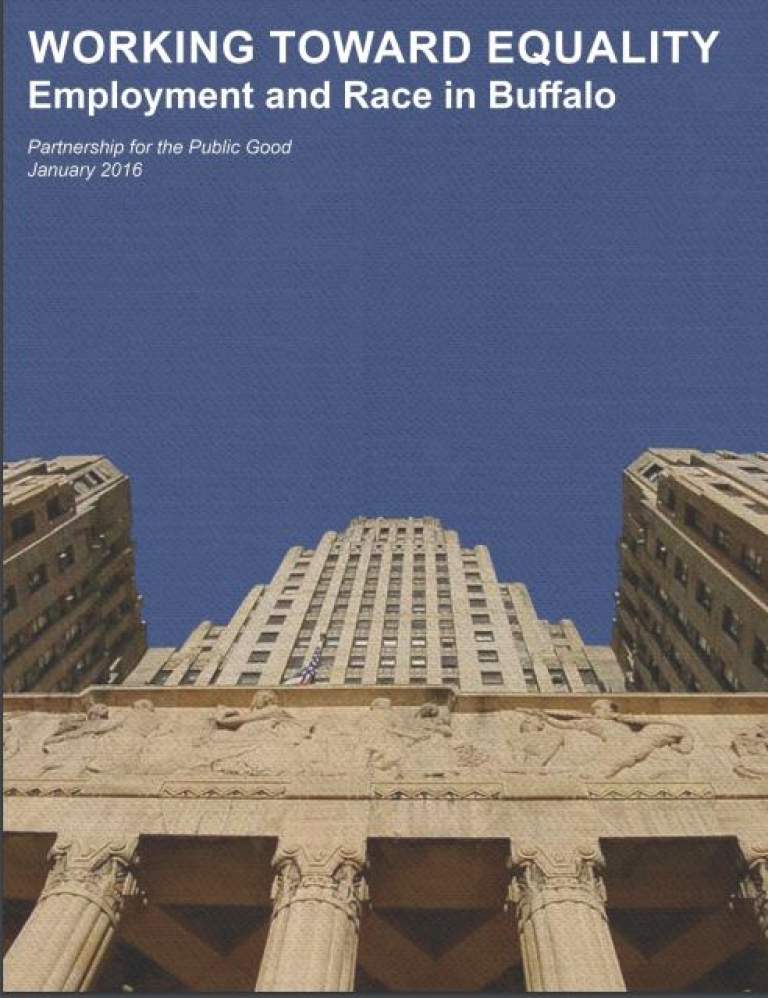
PPG Releases New Report on Employment and Race in Buffalo
Published January 19, 2016
A coalition of labor, community, and religious organizations commissioned the Partnership for the Public Good to produce a comprehensive study on racial employment inequality in the Buffalo-Niagara region. The coalition has released the study, “Working Toward Equality: Employment and Race in Buffalo.” Presenting the findings at the Merriweather Library in Buffalo, the coalition called on the community to join it at a March 18 summit meeting to begin implementing the solutions outlined in the report. Coalition members include: New York State AFL-CIO; WNY Area Labor Federation, AFL-CIO; Buffalo Urban League; Concerned Clergy of Western New York; Baptist Ministers Conference of Buffalo and Vicinity; NAACP Buffalo Branch; Coalition of Black Trade Unions (Buffalo Chapter); and Labor Council for Latin American Advancement (WNY Chapter).
Below are a few key findings from the study:
Scope
- In Buffalo-Niagara, 37% of blacks and Hispanics live below the poverty line, compared to 9% for whites. Median incomes are $25,000 for blacks and $27,000 for Hispanics, compared to $55,000 for whites.
- The 2010-2014 African American unemployment rate was 17.3% and the Hispanic rate 13.6%, compared to a white rate of 6.4%.
- In 2011-2013, the Erie County unemployment rate for black workers ages 20 to 24 was 20.5%, compared to 8.2% for their white counterparts.
- People of color are concentrated in low-wage jobs such as healthcare support, personal care and service, and building and grounds maintenance, and they are dramatically underrepresented in occupations such as management, law, business, and finance.
- In Erie County, black workers earn 71 cents, and Hispanic workers earn 73 cents, for every dollar earned by white workers.
Causes
- Employment discrimination remains prevalent; in one field experiment, employers preferred white applicants with drug felonies to people of color with no criminal record.
- Few companies hold their managers accountable for improving diversity, and many employers use job criteria that do not accurately predict job performance but tend to screen out minorities.
- Buffalo-Niagara is the sixth most segregated metro in the nation, which isolates people of color from job access and creates numerous employability disadvantages.
- Inequalities in wealth, education, criminal justice, and other aspects of life make it harder for people of color to access quality jobs. People of color in Buffalo-Niagara have homeownership rates of less than half those of whites. Blacks represent 14% of the population, but 41% of arrests.
- Rising economic inequality has hurt people of color the most. For example, people of color have lost more from the decline in union density and the erosion of the minimum wage than whites.
- The Great Recession exacerbated employment disparities, as did various austerity policies and governmental cuts made in response.
Solutions
- Targeted hire policies ask companies receiving public assistance to prioritize workers from certain communities, such as zip codes with high poverty rates.
- Local employers should commit to setting goals for improving their diversity and reporting out to the public on progress toward those goals.
- New laws should reform the use of credit checks and criminal histories in hiring.
- The spatial mismatch between people of color and jobs should be addressed with smart growth policies that incentivize business development in densely settled areas on transit lines.
- Direct job creation for disadvantaged workers in targeted communities to rebuild high poverty neighborhoods offers multiple benefits at a low cost.
- Anti-discrimination law enforcement should be more adequately funded and augmented with “tester” programs like those used to identify housing discrimination.
- Improving wages, work supports, and job quality will help people of color to advance. Minimum wage, living wage, paid family leave, paid sick leave, child care assistance, fair scheduling, and renewed rights to organize and bargain collectively will reduce racial disparities and strengthen our economy.